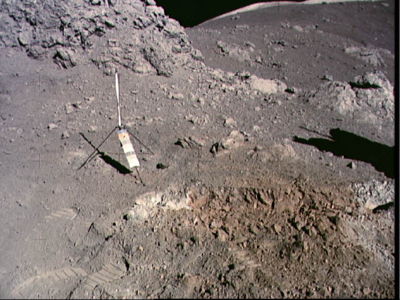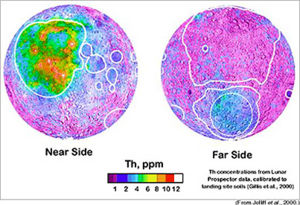Ore Bodies

What Ore Bodies can be found on the Moon?
For a mineral to be recoverable at a reasonable cost it must be found in large enough quantities and concentrated enough that commercial extraction is profitable. Such a concentration is an ore body.
Contents
Where is Ore
Ore bodies are rare. If the concentration is poor, then you will have to process too large an amount of rock to be attractive. If the quantity in a specific location is not large, then it is simply not worth expending the capital setting up an industrial operation. If the location is poor, then the cost to dig the ore out and for transportation out will be prohibitively expensive.
It is far more common to have a mineral dispersed over a large area in too low a concentration to be commercially exploited than to have a viable ore body. These dispersions are very common on the Moon. Such mineral distributions are much easier to spot from space than real ore bodies, but they are of little use to space settlers. Real ore bodies are best investigated by a geologist on the surface, human and robotic.
How are Earth Ore deposits made
DONE.
Making Ore Deposits on the Moon
The Moon has never been wet. The Moon has never had plate tectonics. The surface of the Moon has been continently gardened by meteorites. This mixing dilutes any natural ore concentrations. Valuable ore bodies on the Moon will be very hard to find.
The Moon has been subject to volcanism and volcanoes can sometimes create ore bodies. The most interesting of which would be volatile materials associated with vents. The orange regolith found in Apollo-17 was this type of deposit. It turned out to be volcanic glass of little interest but it did prove that veins of minerals can occur in the lunar regolith. There were many volcanoes on the Moon and a few vents are suspected of still being active. These warrant detailed investigation.
Another possible source of lunar ore deposits is meteorite strikes. This is the predominately geologic process on the Moon. One to two percent of the strikes are by iron and stony iron meteorites. One would think these would create ore bodies. Unfortunately they do not. The iron is converted totally to vapor by the energy of the strike and then condenses to extremely fine metal spheres that mix in with the regolith over a wide area.
The Solar wind
Through the next century the most valuable mineral deposits on the Moon will be those containing volatile compounds. Of most important are hydrogen, oxygen, and later possibly Helium3. The Solar wind has been imparting these compounds into the lunar regolith for billions of years. Some of this material sticks to the surface of the fine rock particles and can be extracted.
The weakness of this plan is that the valuable materials are not concentrated. We will have to process many tons of regolith an hour to extract commercial quantities of volatiles. A smaller operation will, however, be of value to a settlement right from the start to provide their own hydrogen and oxygen.
There are some strong points. First the regolith rock is available on the surface and already ground up. The volatiles stick best to small particles. This eliminates the difficult processes of mining the rock and grinding it up ourselves. Second some types of regolith have held on to their volatiles better than others and these can be identified by their mineral content from low lunar orbit. Those rich in Titanium are particularly attractive.
The biggest advantage however, is that the volatiles can be removed by simple heating, i.e. Volatile Scavenging. First simply sifting the regolith to sort out the fines greatly concentrates the ore. No chemical process is then necessary. The levels and amounts of heat required should be achievable by concentrating solar energy. See Sandworms.
Ilmenite (FeTiO3) ore concentrate
If you are handling lunar regolith for any reason, it is a very simple process to magnetically sort out certain iron bearing minerals. The magnetically sorted fines certainly constitute an ore concentrate that contains:
- Ilmenite (FeTiO3)
- Iron fines consisting of microscopic iron particles embedded in glass beads
- Fine dust sticking to the other particles
- Nanophase iron deposited on smaller grains of regolith that may be picked up during sorting
The most important of these components is Ilmenite (FeTiO3). This mineral contains a lot of oxygen that is only lightly bound in the compound and can be recovered chemically. Magnetically sorting the regolith produces a true ore concentrate of great value to lunar settlers. Heating it in a hydrogen atmosphere at 1200 C for an hour will generate significant amounts of water vapor. This is one of several forms of ilmenite reduction.
After the oxygen is extracted the remaining material remains an attractive source for iron and titanium.
Detailed information on the lunar Ilmenites process can be found at:
Anthony, J. Colozza, Wayne A. Wong, "Evaluation of a Stirling Solar Dynamic System for Lunar Oxygen Production", NASA/TM -- 2006-214360 , Lunar Oxygen
KREEP ore deposits
All of these substances are extremely useful and, if mined, will not have to be imported from Earth's gravity well:

| Contents of KREEP | |
| Chlorine | Zirconium |
| Fluorine | Thorium |
| Potassium | Uranium |
| Phosphorus | Rare Earth Elements |
| Sodium | |
Due to lunar geological processes (see Here) these elements have been concentrated and may prove cheaper to harvest from the moon than other NEOs. KREEP may prove profitable, or it may simply be used for cost reduction (not having to pay shipping from other sources).
Ore Concentration
One attractive possibility is to concentrate the valuable lunar materials into a form that has true economic value. This is a common practice through out the American West today and can be done quite economically on a small scale.
The process usually starts with grinding the ore into a very fine power with ball mill. On the Moon we have a decisive advantage in that the regolith material is already ground to a consistency of at least course sand.
The ore is then mixed in water to form a slurry. This process requires mechanical mixing and often the injection of air. Chemicals are then added to the mix that either move the desired materials into solution or cause them to form a froth of bubbles on top of the solution.
The desired minerals are then separated and the chemicals neutralized. The water is then removed and the dry ore concentrate placed in drums. The drums are impressively heavy.
This process generates concerns for adaptation to our lunar situation both because of the large amount of water required and that some of the chemicals, such as cyanide, are toxic. Still the process is regularly done by small operations with economic success and environmental safeguards at remote locations on Earth and in very dry country.
It would be a very rare ore concentrate that would be worth the cost of shipping back to Earth. Even considering this it is much cheaper to ship mass from the Moon to the Earth than vice-versa. This process is much more believable for material to be used on the Moon, in Earth orbit, or for trips farther out.
Metal Reduction
One common means of obtaining a useful metal from the ore concentrate that might be adapted for the Moon requires that the concentrate be placed in a high temperature crucible. Another mineral, called the flux, is added in crucible and both are heated to a very high temperature with a very large electrical arc.
The flux is chosen such that the impurities in the ore concentrate dissolve much more strongly in the molten flux, called slag, than in the molten metal. The slag usually floats on top and the molten metal is drawn off from under it.
The metal output of this stage is still far from pure and requires farther refinement. For example, gold will be about 80% pure at this stage. Only the most valuable materials would be worth shipping back to Earth. Gold is probably the cheap end of this list but does not occur on the Moon at levels worth talking about. Fortunately some of the KREEP elements might be worth more than gold at this level of refinement.
Another big problem is that this process is economically attractive only in large scales. This is unlike the concentration process. Big processing units will take a very large amount of very high quality power. It will probably be many years before we have power generation facilities on the Moon comparable with the big power damns on Earth.
Still, smaller operations might provide critical materials for off Earth missions much earlier.
Polar Deposits
It is highly likely that hydrogen and its compounds are concentrated in dark craters at the Lunar poles. There are more than a hundred square kilometers of polar crater bottom that has not seen the light of the sun in a billion years. The small amounts of volatile compounds released in comet strikes on the Moon should have accumulated in these areas over geologic time. In our stories these areas are called "the cold and the dark".
We do not currently know the extent or the physical form of these deposits. Finding this information will be one of the first goals of our new lunar explorations.
The polar regions also contain plateaus that are illuminated 80% or more of the time, thus there will be abundant Solar Power available in this area. It is not clear how we will mine these regions.
Electrostatic Placer Deposits
The Lunar day-night "terminator" sets up a powerful voltage differential capable of causing electrostatic dust transport. However, the voltage affects different substances differentially. In particular, metals will have a greater propensity to be transported. Electrostatic separation is an analogous process used in the mining industry to separate metals from ore. In this way, metal particles of elements like gold can be transported many kilometers until they land in permanently shaded craters located at the poles. Since such craters are never exposed to the Sun, any electrostatically transported metals will tend to get concentrated. LCROSS found surprising concentrations of gold, silver and other metals within Cabeus Crater.






